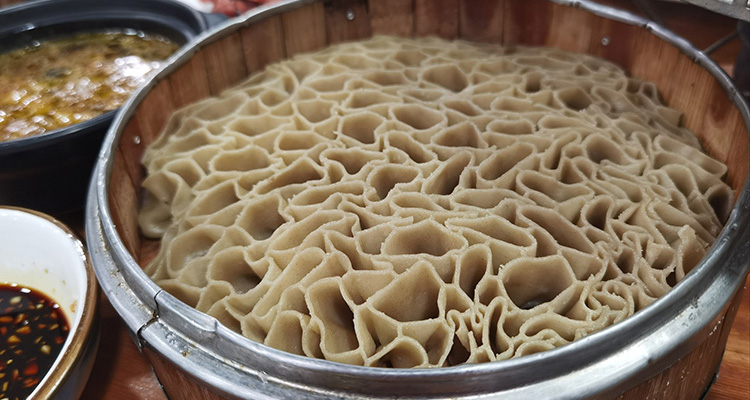Shanxi Oat Kaolao: Tradition and Blessing
Across the northern highlands of China, Shanxi’s cuisine celebrates resilience, resourcefulness, and flavor. One standout specialty is Youmian Kaolao, a golden oat noodle snack cherished for centuries. Born from highland people’s ingenuity rather than imperial kitchens, this humble dish offers both comfort and culinary artistry. Let’s explore its history, ingredients, preparation, tasting tips, and even a simple home version.
1. Origin in the Northern Highlands: A Coarse Grain’s Refined Craft
On Shanxi’s loess plateaus and the cold lands of Yanbei, Youmian Kaolao has flavored local kitchens for generations. Made from oat (youmai), a hardy, cold-resistant grain, this snack thrived on poor soils. The name “kaolao” comes from the small tubular shape of each piece, reminiscent of woven “badu” baskets once used for storing grain. The name reflects the dish’s rustic, homely origins.
2. Cultural Symbolism: From Table Food to Ritual Meaning
In Shanxi, especially Yanbei and Lvliang, kaolao goes beyond nourishment. Its concentric tubes symbolize firmness and unity, and sharing a plate signifies family harmony. It features in life rituals: elders enjoy it on birthdays for longevity, infants receive it at their one-month celebration, and newlyweds eat it to bless their marriage. At year-end banquets, kaolao prays for household harmony and good fortune. The dish embodies Shanxi people’s deep respect for family and continuity.

3. Ingredient Essence: Highland Oat’s Golden Gift
The soul of kaolao is oat flour. Slightly yellow and finely textured, it carries the mellow aroma of northern soils. Highland oats develop full grains rich in protein, fiber, B vitamins, and trace minerals. Oat flour has low gluten, making it harder to work with than wheat flour, but that challenge produces kaolao’s characteristic chew and flavor. Authentic Shanxi kaolao uses the finest oats from Yanbei, processed through rinsing, roasting, and milling into golden flour with a faint nutty fragrance.
4. Handmade Art: A Fingertip Intangible Cultural Heritage
Making Youmian Kaolao is a skilled performance recognized as intangible cultural heritage. Boiling water is poured over oat flour to form a hot dough, then kneaded smooth. Small portions are pinched off and shaped: masters press, roll, and stretch the dough with quick, fluid palm movements into thin, tubular shells. The motions are fast and precise, requiring years of practice. Finished pieces are stacked in a steamer like a golden honeycomb. After 10 minutes of steaming, the oat aroma fills the room.

5. Texture and Taste: A Dual Sensation of Springiness and Tenderness
Fresh from the steamer, kaolao offers a glossy surface, a soft initial bite, and a slightly elastic chew. As you chew, the oat’s nutty, subtly sweet flavor emerges. This fine-grained craftsmanship delivers chewiness without roughness, perfectly balancing soft, resilient, and glossy textures—Shanxi noodles at their best.
6. Versatile Serving Styles: Broth Dip or Stir-Fry Symphony
Youmian Kaolao can be enjoyed in two main ways:
- Dipped in broth (luzi): Hot kaolao is dipped into a rich sauce or soup. Popular options include tangy pickled vegetable broth with Shanxi aged vinegar or minced mutton sauce (yangrou zaozi) with a slightly spicy, meaty flavor.
- Stir-fried: Steamed kaolao is cooled, sliced, and stir-fried with shredded meat, eggs, and local vegetables like cabbage or carrot. Stir-frying gives a light char and allows the noodles to soak up the sauce, creating another delicious variation.

7. Tasting Guide: Eat Like a Local
For authentic kaolao, visit Shanxi cities like Taiyuan, Datong, or Xinzhou. Long-established noodle shops or farmhouse eateries serve the best. When eating: pick up a whole kaolao with chopsticks, dip and roll it in the luzi to combine oat aroma and sauce fully. Stir-fried kaolao is ideal as a shared main dish. Because oat flour is filling, order small side dishes like cold cucumber salad, local pickles, or a bowl of millet porridge for a balanced meal.
8. Traveler Tips: Essential Notes for Food Seekers
- Best places: Try Taiyuan’s Shanxi Huiguan or Lao Taiyuan, Datong’s Fenglingge, and small-town youmian shops in Xinzhou and Shuozhou.
- Best season: Autumn and winter, when steaming kaolao feels especially comforting.
- Drink pairing: Tangy vinegar-based soup or a small bowl of the noodle’s own broth aids digestion.
- Cultural experience: Some folk villages and workshops let visitors watch or try the master’s handcrafting technique.
9. Simple Home Version: Recreating Shanxi Flavor
To try kaolao at home, buy oat flour labeled youmian. Pour boiling water over the flour to form a hot dough, knead, cover, and rest briefly. Divide into small pieces; roll or press into thin sheets, or cut into noodle-like strips for ease. Steam 8–10 minutes. For a quick luzi, use pre-made mutton soup or mix soy sauce, vinegar, minced garlic, chili oil, and cilantro. While it won’t match a master’s finish, it brings Shanxi flavor to your kitchen.
Conclusion
Youmian Kaolao is more than a noodle—it’s Shanxi’s landscape on a plate, a testament to handcraft skill, and a symbol of blessing and family unity. From humble oat flour, it creates a warm, resilient flavor embodying local hopes and traditions. When visiting Shanxi, step into a busy, homey noodle shop, order a steaming steamer of kaolao, dip it in fragrant luzi, and let this chewy, aromatic specialty introduce you to the heart of Shanxi cuisine.


